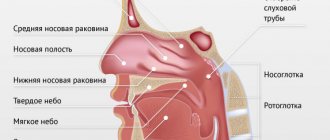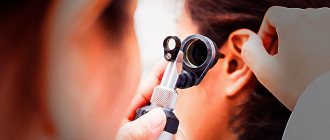Otolaryngologist for adults and children
Son of the gods
Stanislav Vladimirovich
25 years of experience
Otorhinolaryngologist of the highest category, Candidate of Medical Sciences, member of the European Rhinological Society (European Rhinologic Society)
Make an appointment
A wax plug is a collection of earwax in the ear canal. Over time, this formation becomes dense and completely blocks the outer canal of the ear. The patient notices a blockage after a significant decrease in hearing acuity without an objective reason such as injury, infection or neoplasms in adjacent tissues.
Typical signs of cerumen impaction include tinnitus, a feeling of fullness, dizziness, cough, nausea, and pain of variable intensity. The method of removing obstruction depends on the consistency of the cork mass. Common options are rinsing the external auditory canal or dry removal of the plug using instruments. Otolaryngologists do not advise patients to make independent attempts to remove wax plugs from the ear by rinsing the canal with hydrogen peroxide or using cotton swabs, disks and sticks.
General information about pathology
The composition of the wax plug in the ear is formed from the secretion of the skin glands of the external auditory canal. The basis of sulfur is sebum and secretions of the corresponding glandular tissues. Over time, particles of keratinized epithelium and secretion products of apocrine sweat glands are added to them. The color of the substance may vary depending on the dominant element, the age of the patient, the characteristics of metabolic processes in the body, the intensity of physical activity, and the presence of chronic or systemic pathologies.
The main function of the secretion of the glands located in the external auditory canal is to protect the tissue from damage, excessive drying or softening when exposed to water. The acidic environment of sulfur secretions provides an antiseptic effect upon contact with bacteria and fungi, which prevents the development of external otitis. During chewing, speaking and during bouts of yawning, sulfur moves to the outer opening of the ear canal, providing mechanical cleaning of the canal from dirt, dust particles, and small foreign bodies. The formation of wax plugs in adults and children disrupts the functioning of the protective mechanisms of the ear.
Types of cork formations
During the examination of the patient, the otolaryngologist diagnoses the type of cerumen plug formed. The consistency of the secretion of the glands allows us to distinguish the following types of formations in the ear canal:
- pasty - have a light or dark yellow color, plastic;
- plasticine-like – characterized by viscosity and rich brown color;
- hard – dark-colored, have a hard texture, and do not contain moisture.
Removal of ear wax plugs should be performed at the initial stage of their development. The soft formation becomes dense over time, and in advanced cases, rocky. Audiologists and otolaryngologists consider epidermal layers, which are formed from desquamated cells of the stratum corneum of the epidermis, to be a special type of plugs. This type of formation is characterized by high density, white or gray color. A characteristic feature is a tight junction with the walls of the auditory canal, which can lead to the development of bedsores of the bone region.
The location of the plugs makes it possible to distinguish parietal and obstructive forms. In the first case, the accumulation of gland secretions fills part of the external auditory canal, in the second, they completely block it.
Causes
The reasons for the formation of sulfur plugs may be the following:
- Conditions in which the self-cleaning of the external auditory canal is impaired. These can be a variety of diseases - dermatitis , otitis media , eczema . Also, self-cleaning is disrupted due to swelling , the presence of foreign bodies, and inflammation .
- Excessive production of earwax due to increased secretory activity of the glands.
- Improper hygiene care.
There are also a number of factors contributing to the emergence of such formations:
- A large amount of hair in the ear canal.
- A tortuous or narrow ear canal, as a result of which the evacuation of wax is difficult.
- Old age of a person.
- The need to work in conditions of high temperatures or humidity, too low or high atmospheric pressure.
- Regular stay in rooms where there is a lot of dust.
- Use of a hearing aid, constant use of in-ear headphones.
- Frequent and incorrect use of ear sticks, as well as other products not intended for hygienic use. With a stick, you can only remove the outer part of the cork, while the inner part is “pushed” even deeper.
Why does wax plug appear?
Long-term clinical observations of patients have allowed otolaryngologists to accumulate significant knowledge about the causes of cork obstruction of the ear canal. One of the most common reasons for blockage is increased secretory activity of the sulfur glands. Excess secretion does not have time to be removed from the ear canal. Its intensive accumulation provokes the formation of a plug. Hypersecretion becomes a consequence of various pathologies - dermatitis, eczema, chronic otitis. A significant role in stimulating the sulfur glands is played by the level of cholesterol in the blood and the patient’s failure to comply with personal hygiene rules when cleaning the ears.
Difficulty evacuating wax from the ear canal is an equally common cause of obstruction. Impaired outflow of sulfur masses can occur due to anatomical narrowness or excessive lengthening of the ear canal of a child or adult. Pathological changes in tissue due to inflammation, swelling, injury or exposure to foreign objects stimulate blockage of the opening of the outer ear.
A similar effect occurs when patients regularly use in-ear headphones or hearing aids. Elderly people experience problems with the outflow of wax due to active hair growth in the external auditory canal. At risk are people who work in industries with large amounts of dust in the air (mines, tobacco factories, bakeries). Divers and swimmers experience chronic narrowing of the ear canal due to constant skin contact with moisture.
Improper cleaning of the hearing organs remains a significant risk factor for the accumulation of sulfur masses. The production of earwax occurs in the membranous cartilaginous part of the ear, but the patient’s manipulations during hygiene procedures can lead to its entry into the bony part of the ear canal. The narrow isthmus between these sections will not allow the sulfur to return back for successful mechanical evacuation.
Complications
Among the negative consequences are the following conditions:
- allergic manifestations in the form of a rash, itching of the skin, intolerance to the components of the sulfur solvent occurs;
- infection of the middle organ of hearing, with undetected perforation of the ear membrane;
- ear canal injury.
Unremoved serous blockage of the ear is fraught with the following complications:
- chronic otitis;
- increased sweating;
- headaches;
- throbbing pain in the ear;
- itching, burning in the area of the auditory organ;
- stenosis.
Symptoms
Sometimes patients suffering from wax impaction experience ear pain. This is caused by a gradual increase in the size and weight of the sulfur formation. But most adults and children do not experience any discomfort until the ear canal is completely blocked. The consistency of the cork does not play a significant role - the set of characteristics will be the same.
The plugs appear suddenly when water gets into the ear. Contact with liquid provokes a rapid increase in the volume of the sulfur lump. Obstruction of the lumen of the auditory canal develops. The process is accompanied by typical symptoms:
- congestion and noise in the ears;
- decreased hearing acuity;
- an attack of dizziness or headache;
- sensation of a foreign body in the ear canal;
- local pain syndrome.
A common symptom of blockage is autophony - the echo of the patient's own voice in the affected ear while speaking. The pressure of the plug on the eardrum can provoke an attack of nausea, coughing, and migraines. Prolonged compression of the membrane can lead to inflammation - myringitis - and otitis media.
Are you experiencing symptoms of wax plug?
Only a doctor can accurately diagnose the disease. Don't delay your consultation - call
How to remove a plug by washing
Dried sulfur must be softened.
To do this, use a solution of baking soda (3%) or hydrogen peroxide. For two days, drops are applied to the ear three times a day. Then wash the plug out of the ear using a syringe or syringe. Read also: Otosclerosis How to remove the plug correctly:
- Tilt your head over a basin or sink so that water flowing from your ear does not get on your clothes or floor.
- Fill the syringe with warm boiled water (not hot), squeeze out the air and gradually pour water along the ear wall.
- Wax from the ear should be washed out until all the plug is removed from the ear and the discomfort from its presence goes away.
Diagnosis of blockage
The decision on how to remove the wax plug is made by the otolaryngologist after otoscopy or microscopy. A probe directed into the patient's ear allows the consistency of the wax to be determined. An examination of the eardrum is performed to exclude damage from the diagnosis - perforations or ruptures caused by previous diseases.
The condition of the resonating membrane becomes the basis for choosing a method for eliminating obstruction. Otoscopy allows the otolaryngologist to conduct a differentiated diagnosis, excluding the presence of foreign bodies, malignant or benign neoplasms and cholesteatoma in the patient’s ear canal.
How to remove an ear plug at home: methods and tips
Video on how to remove the plug yourself:
There are several options for removing an ear plug yourself.
These methods are recommended to be carried out only after consultation with a specialist and in strict accordance with the instructions for the drug.
Hydrogen peroxide
It is easy to remove stagnation yourself at home using hydrogen peroxide. This method is considered the simplest and most accessible. 3% hydrogen peroxide is used. If the solution is of higher concentration, the possibility of a chemical burn cannot be ruled out. 2-3 drops of solution are dripped into the ear using a pipette. In this case, the patient should lie with his head with the second ear on the pillow.
- Earwax in the ear: symptoms, removal at home
After this, a slight hissing and burning sensation will be felt in the ear - this is normal. You need to stay in this position for 10–15 minutes. After this time, turn your head to the other side and place a napkin under your ear. If everything went well, the remainder of the peroxide with pieces of wax will flow out of the ear. Such manipulations must be repeated three times a day for 3 days. This is due to the fact that it is not possible to completely remove the plug in one procedure.
If pain occurs, you should immediately get up and try to pour the remaining solution out of your ear, and then go to see a specialist.
Drops
This option is considered not only effective, but also safe. It can also be used to remove ear plugs in young children. To do this, you need to lie on your side on a pillow and drop the number of drops of solution specified in the instructions into the ear canal. After 3 minutes, the drug will completely dissolve the sulfur. It can be removed from the passage by simple washing.
Candles
You can get rid of sulfur stagnation using special candles. They can be purchased ready-made at the pharmacy, or you can make them yourself from propolis, beeswax or medicinal herbs.
There are several types of herbal candles: with propolis, herbal, essential. Their advantage is that they contain natural components that do not have a negative effect on the mucous membrane.
To remove the plug with phyto-candles, you need to first treat the ear shell with baby cream and cover it with a small napkin with a hole. After this, light the upper part of the candle and place the lower edge to your ear. After a third of the candle burns out, dip the rest into a glass of water. Wipe off any remaining candles. Insert a tampon into the ear canal.
After 5-10 minutes, the congestion will soften and come out of the ear. The essence of the action of a candle is that during combustion, heat and vacuum are formed, which promotes softening and removal of sulfur.
Ear blowing
Some people decide to remove or break through stagnant sulfur at home by blowing it out on their own.
This option is considered the most dangerous and is used in case of emergency upon the recommendation of a specialist.
- “Earwax in children can lead to hearing loss”
Several methods of blowing are known:
- Valsalvas;
- Toynbee;
- Politzer.
At home, it is possible to use only the first method (Valsalva). Its essence is that the patient needs to take a deep breath and, holding his nose, try to exhale the air. Coming from the lungs, air under pressure enters the Eustachian tube, from where it is directed to the eardrum. This leads to the squeezing out of stagnation.
Removing wax plug
Attempts by patients to independently remove wax plugs by dissolving with drops or removing with tweezers can lead to injury to the skin of the external auditory canal, damage to the eardrum, the development of infections, and the progression of otitis media or otomycosis. Any manipulations related to wax lumps in the ears should be entrusted to an otolaryngologist.
Soft plugs are removed by washing. This method is not used if the integrity of the eardrum is damaged - the fluid will enter the middle ear cavity, causing an acute inflammatory process. Paste-like and plasticine-like plugs are removed immediately after diagnosis when the integrity of the resonating membrane is confirmed.
The washing process involves the use of a Janet syringe, into which a sterile saline solution or furatsilin solution is drawn. The temperature of the liquid is 37 degrees Celsius. Heating of solutions is mandatory, since low temperatures will have an irritating effect on the skin of the ear canal and will ensure the manifestation of increasing reflex reactions - dizziness, nausea, headache.
Before removal, hard plugs are softened with a solution of hydrogen peroxide instilled into the patient's ear by an otolaryngologist. The solution is preheated. The duration of the softening process depends on the type of plug formation. The preparatory stage can last several days - instillations are carried out three times for every full day. A side effect of hydrogen peroxide entering the ear canal is increased hearing loss. The reason for this phenomenon is the swelling of the cerumen plug under the influence of liquid and increased obstruction of the ear canal.
If there are contraindications to washing the ears, dry instrumental removal of the wax is performed. The manipulation is carried out using otolaryngological instruments: an ear hook, forceps and a spoon. The process of removing the plug is carried out under visual control using a microscope. Successful removal of the lump by the otolaryngologist is completed by introducing a turunda soaked in boric acid into the patient’s ear canals. After 2-3 hours, the tampon is removed. A child or adult can do their usual activities without any restrictions.
Treatment
Treatment of this disease is carried out using several methods:
- by washing - if the sulfur plug is of a soft consistency, then it can be washed out with a warm aqueous solution. To do this, the liquid is injected into the ear cavity under pressure using a Janet syringe;
- aspiration (suction) with an electric suction – also suitable for soft sulfur masses;
- curettage – removal of the ear plug with a special probe;
- removal by dissolution method - for this, ear drops are used to help soften and dissolve earwax.
Prevention
The basis of prevention is an explanatory conversation between the otolaryngologist and the patient. Improper ear cleaning remains the main cause of earwax in children and adults. The doctor clearly demonstrates the principles of hearing hygiene.
The main mistake most people make is dipping cotton swabs into the ear canal. This leads to compaction of sulfur accumulations and the formation of plugs. Cleansing procedures should only affect the auricle and the skin around the auditory opening. Other manipulations are fraught not only with the formation of sulfur lumps, but also with damage to the internal tissues of the ear.
It is beneficial for children and adults to attend preventive examinations every 6 months. An otolaryngologist will diagnose the condition of the ear canals and ensure their professional hygiene. This option is indicated for people suffering from regularly formed sulfur plugs.
An important component of prevention remains the timely treatment of viral infections and systemic pathologies of the body, which can lead to complications, including sulfur plugs. If there is severe overproduction of earwax, the patient should consult with a dermatologist, endocrinologist, therapist, or gastroenterologist. Finding the reasons that provoke increased work of the glands will help doctors develop an effective treatment strategy.
Parents raising small children are advised to clean their children's ears themselves. A child's undeveloped motor skills can lead to injuries when using cotton swabs. Moms and dads should pay special attention to explanatory conversations about the inadmissibility of placing small foreign objects in the child’s ear canals during games with peers.
In children
Ear wax in a child is not uncommon. As a rule, it is not difficult to diagnose, and the presence of such lumps is often detected by a pediatrician during a routine examination. However, if not removed in a timely manner, such a formation in a child can provoke inflammatory processes in the ear, hearing impairment, and perforation of the eardrum. A child who is bothered by traffic jam may have trouble sleeping and be restless.
Removal of the lump should only be carried out by a specialist. Subsequently, parents should properly clean the baby’s ears, carrying out this procedure once a week. You need to clean your ears carefully, in a circular motion, and only from the outside of the ear canal. You can also use special drops that can be used to care for the ear cavity in children. Your pediatrician can recommend them.
How to make an appointment with the specialists of JSC "Medicine" (clinic of academician Roitberg)
You can make an appointment with the specialists of JSC "Medicine" (clinic of Academician Roitberg) on the website - the interactive form allows you to select a doctor by specialization or search for an employee of any department by name and surname. Each doctor’s schedule contains information about visiting days and hours available for patient visits.
Clinic administrators are ready to accept requests for an appointment or call a doctor at home by calling +7 (495) 775-73-60.
Convenient location on the territory of the central administrative district of Moscow (CAO) - 2nd Tverskoy-Yamskaya lane, building 10 - allows you to quickly reach the clinic from the Mayakovskaya, Novoslobodskaya, Tverskaya, Chekhovskaya and Belorusskaya metro stations .










